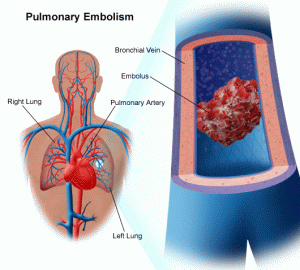Pulmonary embolism (PE) is a blockage of the main artery of the lung or one of its branches by a substance That has Travelled from elsewhere in the body through the bloodstream (embolism). (Wikipedia)
Causes
Most cases of pulmonary embolism according to Brunner and Suddarth caused by
1. Blood clot
2. Air bubble
3. Fat
4. Tumor cells
- Pulmonary Embolism (PE)
Overview
Causes
Clinical Manifestations
Pathophysiology
Diagnostic Examination
Investigations
Complication
Medical Management

Clinical Manifestations
The symptoms of pulmonary embolism depends on the size of the thrombus and the area of the pulmonary artery is clogged by a thrombus. The symptoms may be nonspecific. Chest pain is the most common symptom and usually has a sudden onset and is pleuritic. Subternal sometimes can and can mimic angina pectoris or myocardial infarction. Dyspnea is the second most common symptom is followed by tachypnea, tachycardia, nervousness, cough, diaphoresis, hemoptysis, and syncope.
Massive embolism of the pulmonary artery bifurcation clog could cause actual dyspnea, substernal pain sudden, rapid and weak pulse, shock, syncope and sudden death.
Multiple small embolism can get stuck in the terminal pulmonary arteries, resulting in multiple small infarcts in the lungs. Clinical picture may resemble bronchopneumonia or heart failure. (Brunner and Suddarth)
Pathophysiology
When the thrombus blocking some or all pulmonary arteries, enlarged alveolar space loss due to the area, although they keep getting ventilation, receive little or no blood flow at all. In addition a number of substances that are released from the clot and cause the blood vessels constrict bronchiolus. This reaction in seimbangi ventilation perfusion imbalance, resulting in decreased O2 and increased CO2 levels.
Hemodynamic consequence is an increase in pulmonary vascular resistance due to decrease in size of pulmonary vascular net-nets., Causing an increase in pulmonary artery pressure and ultimately improve the working right ventricle to maintain pulmonary blood flow. When the right ventricle needs exceed the capacity, it will happen right ventricular failure that leads to a decrease in systemic blood pressure and shock. (Brunner and Suddarth)
Diagnostic Examination
Diagnostic examination of pulmonary embolism according to Brunner and Suddarth, are:
1. Chest X-rays
Chest radiograph in pulmonary embolism is usually normal but may shows a pneumo-constriction, infiltrates, atelectasis, elevation diagfragma the position of the sick, or dilation of the arteries and pleural effusion.
2. ECG
ECG usually shows sinus tachycardia, atrial flutter or fibrillation and right axis deviation possible, or right ventricular strain.
3. Impedance Plethysmography
Plethysmography impedance performed to determine the presence of deep venous thrombosis.
4. Arterial blood gas
Arterial blood gases on pulmonary embolism may show hypoxemia and hipokapnea.
Investigations
Diagnostic examination that is often found on client pulmonary embolism as proposed by Doenges, M. E. (2000) the following:
- Lung scan (ventilation / perfusion scan) can show abnormal perfusion pattern in the area of ventilation or absence of ventilation and perfusion.
- Pulmonary angiography: the presence of defects or cutoff in the absence of arterial blood in the distal blood flow.
- Chest X-ray: often normal (especially in the subacute state), but may show a shadow of blood clots, damage to blood vessels, elevation of the diaphragm on the affected area of pleural effusion, infiltration consolidation.
- ABGs: PaO2 may indicate a decrease, Paco, (hypoxemia, hipokapnea) and elevation of pH (respiratory alkalosis), especially if severe pulmonary obstruction.
- Complete blood: may show increased HT (hemoconcentration) increased red blood cell polistemia.
- ECG : May be normal or show changes in the right ventricle that identify disorders, such as changes in ST segment or T waves, axis deviation / right bundle branch block (RBBB), tachycardia and dysrhythmias often occur.
Complication
Complications resulting from pulmonary embolism are:
1. Respiratory failure,
2. Acute right heart failure, and
3. Hypertension
Medical Management
According to Brunner and Suddarth (2001) The goal of treatment is to destroy (lyse) embolism pmbentukan existing and prevent new ones. Treatment of pulmonary embolism can include a variety of modalities:
- Anticoagulant therapy. Anticoagulation therapy include heparin, warfarin sodium has traditionally become the primary method to cope with acute deep vein thrombosis and pulmonary embolism.
- Thrombolytic therapy. Thrombolytic therapy include urokinase, streptokinase may also be used in dealing with pulmonary embolism, especially in highly disturbed paien. Thrombolytic therapy destroys thrombus or emboli faster and restore hemodynamic function of the pulmonary circulation is greater, because reducing pulmonary hypertension and improve perfusion, oxygenation, and cardiac output.
- Common action to improve the status of respiratory and vascular. Common actions undertaken to improve the status of respiratory and vascular patients. Oxygen therapy is given to correct hypoxia and to eliminate pulmonary vascular vasoconstriction and pulmonary hypertension and reduced.
- Surgical intervention. Surgical intervention is carried out embolectomy lung, but embolectomy may be indicated in the following conditions:
a. if patients had persistent hypotension, shock, and severe heat
b. if very high pulmonary artery pressure
c. if the angiogram showed obstruction of the pulmonary blood vessels.
Embolectomy pulmonary require thoracotomy with cardiac pulmonary bypass technique
Tags : pulmonary artery, pulmonary fibrosis, pulmonary edema, signs pulmonary embolism, symptoms pulmonary embolism, pulmonary embolism definition, pulmonary embolism causes, pulmonary embolism cancer, pulmonary embolism ecg, pulmonary hypertension, treatment pulmonary embolism, acute pulmonary embolism, pulmonary embolism diagnosis, blood clot
Reading this post adds more knowledge about pulmonary fibrosis. Also, this helps us to avoid this kind o illness.
Some really useful slides here. I've been looking for something like this to help with a research piece I've been working on.
Kyphoplasty